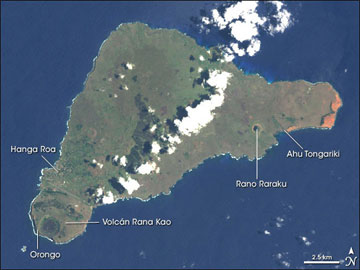Easter Island’s demise caused by rats, Dutch traders says new theory
Rhett A. Butler, mongabay.com
December 6, 2005
Rats and European traders may be responsible for the mysterious demise of Easter Island according to research presented last week by a University of Hawaii anthropologist during an American Anthropological Association meeting.
Anthropologist Terry Hunt and colleagues say that introduced Polynesian rats may have caused the deforestation of the island’s 16 million palm trees which were key to sustaining Easter’s human population.
The history of Easter Island, its statues and its peoples, has long been shrouded in mystery. Some have suggested that aliens marooned on earth planted the statues as signals to their fellow aliens to rescue them. Others have said that the statues were constructed by a great race of guilders that were stranded on the island and built them before being rescued. Still others are convinced that an ancient society endowed with flight technology constructed them along with the Nazca lines in Peru. However new evidence based on pollen analysis supports a much simpler theory, that the Easter Island inhabitants destroyed their own society through deforestation and the introduction of invasive species — specifically, a rat.
When Easter Island was “discovered” by Europeans in 1722, it was a barren landscape with no trees over ten feet in height. The small number of inhabitants, around 2000, lived in a state of civil disorder and were thin and emaciated. Virtually no animals besides rats inhabited the island and the natives lacked sea-worthy boats. Understandably, the Europeans were mystified by the presence of great stone statues, some as high as 33 feet (10 m) and weighing 82 tons (75 metric tons). Even more impressive were the abandoned statues-as tall as 65 feet and weighing as much as 270 tons. How could such a people create, and then move such enormous structures? The answer lies in Easter islands’ ecological past, when the island was not a barren place.
 Image courtesy of NASA
A researcher at Rochester Institute of Technology is unraveling a mystery surrounding Easter Island. William Basener, assistant professor of mathematics, has created the first mathematical formula to accurately model the island’s monumental societal collapse. Computer simulations using Basener’s formula predict values very close to the actual archeological findings on Easter Island. His team’s results were recently published in SIAM Journal of Applied Math. |
The Easter Island of ancient times supported a sub-tropical forest complete with the tall Easter Island Palm, a tree suitable for building homes, canoes, and latticing necessary for the construction of such statues. With the vegetation of the island, natives had fuelwood and the resources to make rope. With their sea-worthy canoes, Easter Islanders lived off a steady diet of porpoise. A complex social structure developed complete with a centralized government and religious priests.
It was this Easter Island society that built the famous statues and hauled them around the island using wooden platforms and rope constructed from the forest. The construction of these statues peaked from 1200 to 1500 AD, probably when the civilization was at its greatest level. However, pollen analysis shows that at this time the tree population of the island was rapidly declining as deforestation took its toll.
Around 1400 the Easter Island palm became extinct due to overharvesting and as Hunt argues, Polynesian rats, which severely reduced the palm’s capacity to reproduce by eating its seeds. In the years after the disappearance of the palm, ancient garbage piles reveal that porpoise bones declined sharply. The islanders, no longer with the palm wood needed for canoe building, could no longer make journeys out to sea. Consequently, the consumption of land birds, migratory birds, and mollusks increased. Soon land birds went extinct and migratory bird numbers were severely reduced, thus spelling an end for Easter Island’s forests. Already under intense pressure by the human population for firewood and building material, the forests lost their animal pollinators and seed dispersers with the disappearance of the birds. Today, only one of the original 22 species of seabird still nests on Easter Island.
With the loss of their forest, the quality of life for Islanders plummeted. Streams and drinking water supplies dried up. Crop yields declined as wind, rain, and sunlight eroded topsoils. Fires became a luxury since no wood could be found on the island, and grasses had to be used for fuel. No longer could rope by manufactured to move the stone statues and they were abandoned. The Easter Islanders began to starve, lacking their access to porpoise meat and having depleted the island of birds. As life worsened, the orderly society disappeared and chaos and disarray prevailed. Survivors formed bands and bitter fighting erupted. By the arrival of Europeans in 1722, there was almost no sign of the great civilization that once ruled the island other than the legacy of the strange statues. However, soon these too fell victim to the bands who desecrated the statues of rivals.
 |
While tribal warfare likely reduced the population of Easter Islanders, Hunt suggests that most of the decline probably was resulted from early 18th-century Dutch traders, who brought diseases and took slaves from the island. Research elsewhere indicates that “first contact” diseases — like typhus, influenza and smallpox — carry extremely high mortality rates, often exceeding 90%. The first traders to reach the island likely carried such diseases which would have rapidly spread among the islanders and decimated the population.
Today Easter island is part of Chile and relies on tourism to sustain its small population. All that remains of the once great society is a few stone relics from the past.
This story used information from previous mongabay.com articles, UPI, and Jared Diamond’s Guns, Germs, and Steel and his later work, Collapse: How Societies Choose to Fail or Succeed.